How Manstein Saved the German Army from Disaster in Early 1943
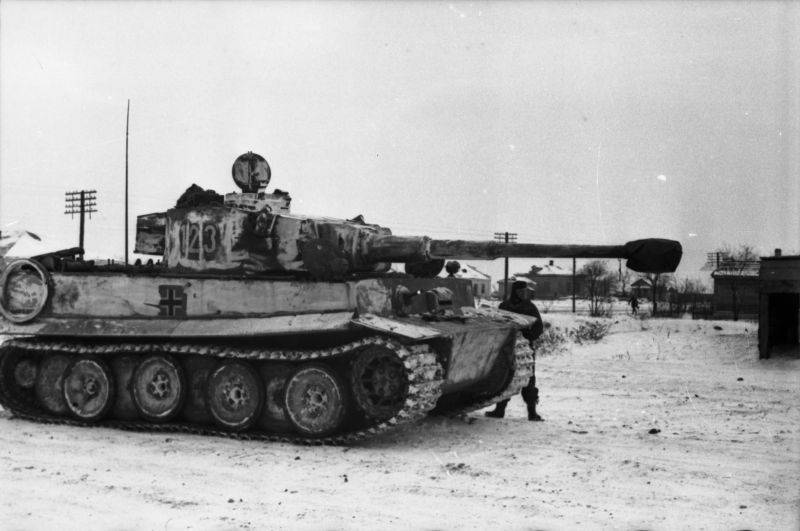
German tank Pz. Kpfw. VI "Tiger" from the 503rd heavy tank battalion near Rostov-on-Don. January 1943
To Rostov
On January 1, 1943, after the completion of the Kotelnikovsky battle (the German operation "Winter Thunderstorm"), which buried the hopes of the German command to release the army of Paulus, the troops of the Stalingrad Front, renamed the Southern Front, without a pause, launched an attack on Rostov and Tikhoretskaya. There was a threat of defeating the entire German southern wing of the Eastern Front (How the Soviet Headquarters prepared the Caucasian cauldron).
The commander of the German Army Group Don, Erich von Manstein, had only 500 German divisions on the 15 km front line. At the same time, part of the divisions had already been defeated. So, from the 57th tank corps, which in December 1942 tried to break through to Stalingrad to save the 6th army, almost nothing remained. In the same situation was the 22nd tank division, it will be disbanded in March. The three airfield divisions of the Luftwaffe were fresh and complete, but their combat effectiveness was noticeably less than that of the Wehrmacht divisions.
The allied Romanian divisions showed low combat readiness when they had to hold the blow, and not advance behind the Germans. So the 3rd Romanian army was almost completely destroyed in the Battle of Stalingrad. The Romanian 4th Army suffered heavy losses. The remaining divisions of the 4th Army took part in Operation Winter Thunder, covering the German flanks. Here the Romanian formations were completely demoralized. They had to be removed from the front and sent to the rear for reorganization. Thousands of Romanians surrendered.

To the north of Millerovo, on the left wing of the Don group, where the 8th Italian Army had previously been (completely defeated), a 100-kilometer gap gaped. It was hastily closed by a hastily knocked together group "B" of General Fretter-Pico (2 divisions). Two armies of the Southwestern Front acted against Group B - Kharitonov's 6th Army and Kuznetsov's 1st Guards Army.
In the large bend of the Don at the turn of the Bystraya and Tsimla rivers, the task force of General Hollidt, 200 divisions (including 10 tank divisions: 3th, 6th and 11nd), held a 22-kilometer section of the front. In the area of the German air bases Tatsinskaya and in Morozovsk, the German 48th tank corps of von Knobelsdorf fought back. From the north and east, the Hollidt group was attacked by the Soviet 3rd Guards, 5th Tank and 5th Shock Armies.
South of the Don, at the turn of the Kuberle River, the remnants of the 4th tank army of Gotha (17th and 23rd tank, 15th air field, 5th motorized division of the SS Viking) defended themselves. South, at the turn of the river. Manych, the 16th motorized division of Schwerin, transferred from Elista, was located. Goth's troops held back the attacks of the 2nd Guards, 51st and 28th armies.
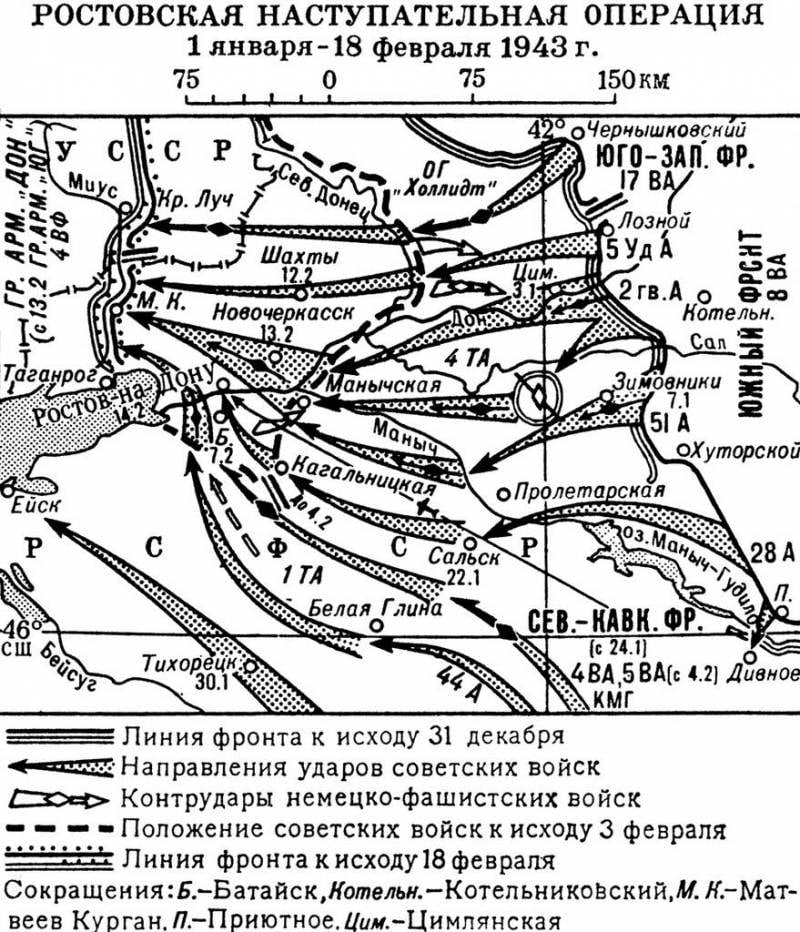
The striking power of the Red Army
In the seven armies of the South-Western (SWF) and Southern Fronts (South Front), which carried out the Rostov operation, there were over 700 thousand soldiers and officers. And the attack was 17 tank and mechanized corps. The tank and mechanized troops of the Red Army were restored in 1942. This was due to two main factors:
1) a significant increase in military production, including armored vehicles;
2) the need for offensive operations.
By January 1943, the Red Army had 24 tank and 8 mechanized corps. In 1942, the first two tank armies of mixed composition were created (together with 2 tank corps, they included cavalry and rifle divisions, separate tank brigades).
At the same time, heavy breakthrough tank regiments were formed, armed with tanks of the KV or Churchill type. Most of the armored formations were in the south - as part of the South-Western, Southern and Donetsk fronts.
The tank corps had 3 tank and 1 motorized rifle brigade, other units and subunits. A total of 7 men, 800 tanks and 168 guns and mortars. The mechanized corps included 100 mechanized and 3 tank brigade, anti-tank and anti-aircraft artillery regiments, other units and subunits. A total of 1 thousand people, 15-175 tanks, more than 224 guns and mortars. In terms of combat capabilities, the Soviet mechanized corps was approximately equal to the German tank division (about 150 thousand people, 17 tanks and self-propelled guns, more than 200 guns and mortars).
According to the order of the People's Commissar of Defense of October 16, 1942, armored formations should be used in the offensive in the direction of the main front strike after the combined arms formations had overcome the main defensive zone as a success development echelon. In defense, tank formations were used to carry out counterattacks. However, in practice, our commanders often threw tank corps against the unsuppressed and poorly explored enemy defenses in order to break through the enemy defenses. In defense, tanks plugged any gaps in the front. This led to heavy losses of mobile units in manpower and equipment.
The training of personnel and command personnel of mobile units was also very lame. The hulls were thrown into battle raw. Intelligence was unsatisfactory, the interaction of tanks with infantry and vice versa, as well as tanks with artillery, was poorly organized. The interaction was superficial. Part of the tank formations were sprayed, the blows were "spread fingers". They attacked in the forehead, squeezed out the enemy, did not use the opportunities for coverage, bypass and encirclement. The commanders were afraid of encirclement, so as not to fall into the cauldron themselves. This led to heavy losses, the potential of offensive operations was used only partially. The Germans managed to retreat, regroup forces and delivered strong counterattacks.
For example, during the Kozelsk battle (counterattack of the left wing of the Western Front in the area of Sukhinichi and Kozelsk - August-September 1942), the Soviet 3rd tank army, which received 510 tanks, lost 45% of its personnel and more than 50 % of combat vehicles, burned a bunch of ammunition and fuel, and recaptured an area 20 km wide and 7-8 km deep from the enemy.
It is worth noting that during the current Ukrainian campaign, Russian generals repeated these mistakes of the Soviet command. Exploration failed. The interaction of forces and combat arms is poor. Management and communications are unsatisfactory. The most powerful fortified areas of the enemy are storming in the forehead. Although military science teaches that the best forms of combat are encirclement, bypass and encirclement. The thought of the need to form several tank and armies and 20-30 corps and divisions in order to carry out deep breakthroughs, apparently, did not reach. The command is obviously afraid to go for a deep breakthrough, after an unsuccessful blitzkrieg at the beginning of the campaign. Since they can only attack in company battalion groups. In general, the lessons will be difficult. God grant you have time to learn how to fight before you have to butt heads with NATO battle groups and divisions.
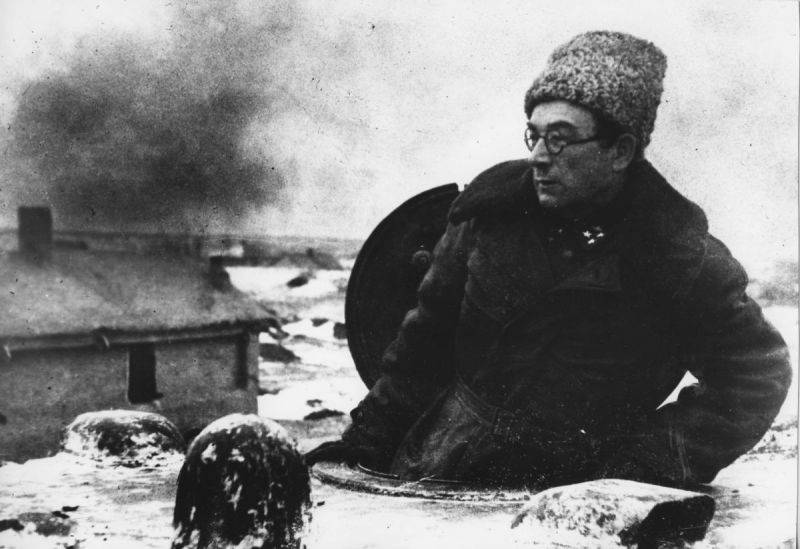
Commander of the 7th Tank Corps of the Red Army, Lieutenant General Pavel Alekseevich Rotmistrov in the turret hatch of the KV-1 tank in Kotelnikovo. End of December 1942
Mission Impossible
At the same time, the Red Army learned quickly. Manstein noted that during the Stalingrad operation, the Russian command acted quite energetically and learned a lot from the beginning of the war. Especially with regard to the organization and use of large tank formations. The Russians organized tank corps and used deep penetration tactics.
The German headquarters in January 1943 set extremely difficult tasks for Manstein. Continue measures to save the army of Paulus. At the same time, cover the rear of Army Group A, its communications that passed through Rostov-on-Don. The Don group was reinforced only by the 7th Panzer Division. At the same time, the Fuhrer demanded to fight for every inch of Russian land. It was a dispute between a military and political leader.
It was clear to the military that it was necessary to maneuver, to give up territory in order to save the army. Hitler operated on political and economic factors. He could not voluntarily surrender the occupied lands. I thought about the coal of the Donbass, the oil of Maykop, the bread of Ukraine, etc. It was impossible to refuse to save the army of Paulus. Therefore, the order of the German Headquarters was appropriate: "Stand to the death!" In particular, to keep the airfields of Morozovsk and Tatsinskaya, from where the air bridge went to the garrison of Stalingrad.
As a result, Manstein created a real strategic miracle. He relied on well-coordinated maneuver actions, not being afraid to weaken secondary sectors of the front, or even leaving previously occupied territories.
All requests from the headquarters of Army Group Don to transfer at least three divisions from Group A to reinforce the Goth tank army were refused from the German headquarters. Therefore, Manstein put an end to the army of Paulus. However, the "Stalingrad fortress" was supposed to hold out as long as possible, holding down the Russian troops. Manstein's troops were supposed to maneuver, launch counterattacks, if necessary, then surrender secondary positions, hold Rostov by any means and ensure the withdrawal of the 1st Panzer Army. It was supposed to carry out the transfer of forces from the right flank to the left and organize a strong counterattack in order to regain all previously lost positions by spring.
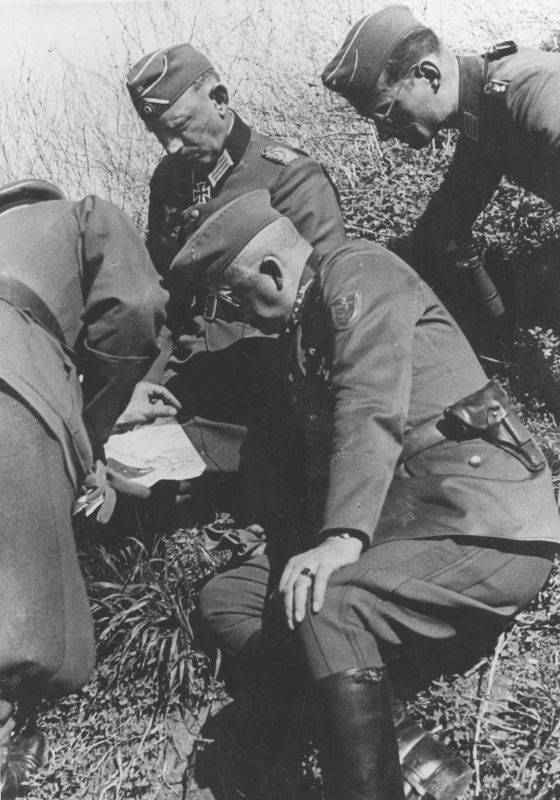
Field Marshal Erich von Manstein with officers at the map in the Don region. 1943
Active defense
First, it was necessary to hold the front, not to let it fall apart. The evacuation of Mackensen's 1st Panzer Army from the North Caucasus required 25 days for Army Group A, according to Kleist's report.
Already on January 5, 1943, Manstein surrendered Morozovsk. He put the High Command of the Wehrmacht before a choice: either he makes a decision that suits the situation, or resign. The Don group simply did not have the physical ability to simultaneously save the 6th Army, hold the front along the entire line and cover the withdrawal of troops from the Caucasus. And even more so - to repel all Russian attacks and regain lost positions. There were no reserves. Anti-aircraft gunners were thrown into battle, battle groups that were put together from the rear, vacationers and convalescents.
Therefore, the Hollidt group slowly backed away to the Seversky Donets, preventing the Russians from breaking through to the crossings at Belaya Kalitva, Kamensk-Shakhtinsky and Voroshilovgrad. Thus, the Germans closed the approaches to Rostov from the north.
In this direction, the powerful 3rd Guards Army of the SWF under the leadership of Lelyushenko tried to break the German defense - 9 guards, rifle, motorized rifle and artillery divisions, 3 brigades, 1st guards mechanized, 2nd guards and 25th tank corps. In early January, Lelyushenko's army will receive two fresh tank corps - the 2nd and 23rd. They will be thrown into the breakthrough to Kamensk. In the same direction, Popov's 5th tank army was advancing - the 1st and 2nd tank corps, three rifle divisions. Popov's army developed an offensive against Tatsinskaya, which was 45 km away. It took 10 days to reach her.
Kamensk, which was defended by the Fretter-Pico group, and a month later was with the Germans. The German infantry skillfully defended themselves. General Hollidt maneuvered his three panzer divisions. German tanks were timely deployed to dangerous places, delivered short but sensitive counterattacks. By the end of January 1943, there were almost no tanks left in the tank corps of the 3rd Guards Army.
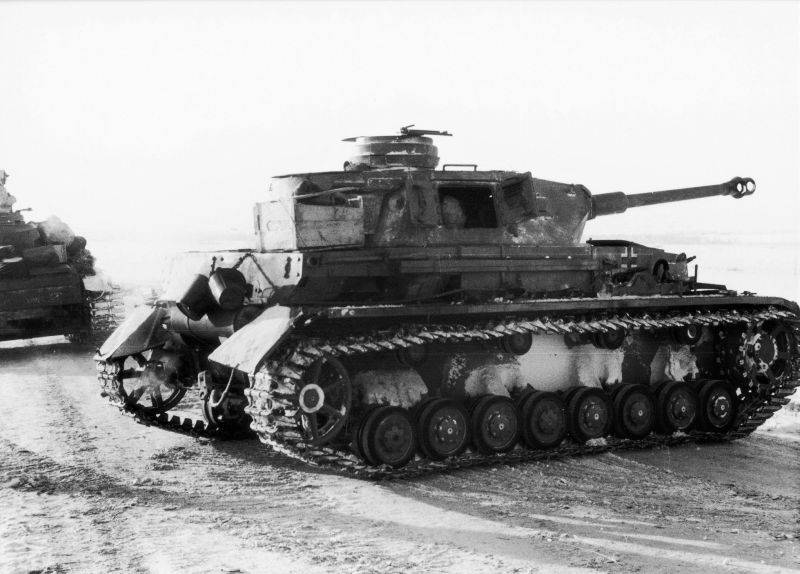
German tank Pz. Kpfw. IV Ausf. G near the village of Kotelnikovo. Vehicle fitted with winter tracks (Winterketten), December 1942.
To be continued ...
- Alexander Samsonov
- https://ru.wikipedia.org/, http://waralbum.ru/
Information